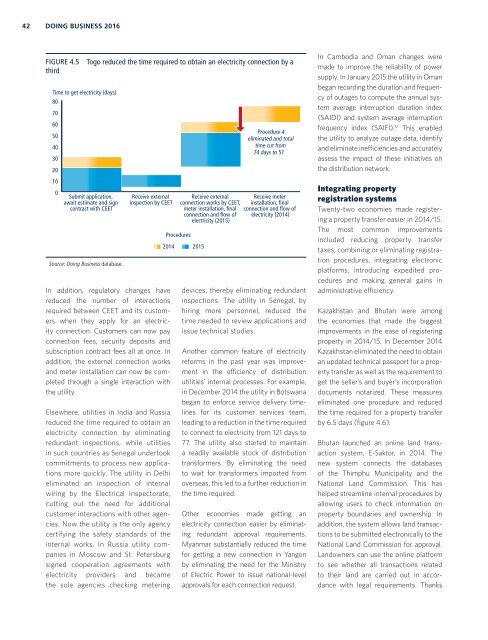Doing Business 2016
1LWKJHK
1LWKJHK
Create successful ePaper yourself
Turn your PDF publications into a flip-book with our unique Google optimized e-Paper software.
42<br />
<strong>Doing</strong> <strong>Business</strong> <strong>2016</strong><br />
Figure 4.5 Togo reduced the time required to obtain an electricity connection by a<br />
third<br />
Time to get electricity (days)<br />
80<br />
70<br />
60<br />
50<br />
40<br />
30<br />
20<br />
10<br />
0<br />
Submit application,<br />
await estimate and sign<br />
contract with CEET<br />
Source: <strong>Doing</strong> <strong>Business</strong> database.<br />
Receive external<br />
inspection by CEET<br />
In addition, regulatory changes have<br />
reduced the number of interactions<br />
required between CEET and its customers<br />
when they apply for an electricity<br />
connection. Customers can now pay<br />
connection fees, security deposits and<br />
subscription contract fees all at once. In<br />
addition, the external connection works<br />
and meter installation can now be completed<br />
through a single interaction with<br />
the utility.<br />
Elsewhere, utilities in India and Russia<br />
reduced the time required to obtain an<br />
electricity connection by eliminating<br />
redundant inspections, while utilities<br />
in such countries as Senegal undertook<br />
commitments to process new applications<br />
more quickly. The utility in Delhi<br />
eliminated an inspection of internal<br />
wiring by the Electrical Inspectorate,<br />
cutting out the need for additional<br />
customer interactions with other agencies.<br />
Now the utility is the only agency<br />
certifying the safety standards of the<br />
internal works. In Russia utility companies<br />
in Moscow and St. Petersburg<br />
signed cooperation agreements with<br />
electricity providers and became<br />
the sole agencies checking metering<br />
Receive external Receive meter<br />
connection works by CEET, installation, final<br />
meter installation, final connection and flow of<br />
connection and flow of electricity (2014)<br />
electricity (2015)<br />
Procedures<br />
2014 2015<br />
Procedure 4<br />
eliminated and total<br />
time cut from<br />
74 days to 51<br />
devices, thereby eliminating redundant<br />
inspections. The utility in Senegal, by<br />
hiring more personnel, reduced the<br />
time needed to review applications and<br />
issue technical studies.<br />
Another common feature of electricity<br />
reforms in the past year was improvement<br />
in the efficiency of distribution<br />
utilities’ internal processes. For example,<br />
in December 2014 the utility in Botswana<br />
began to enforce service delivery timelines<br />
for its customer services team,<br />
leading to a reduction in the time required<br />
to connect to electricity from 121 days to<br />
77. The utility also started to maintain<br />
a readily available stock of distribution<br />
transformers. By eliminating the need<br />
to wait for transformers imported from<br />
overseas, this led to a further reduction in<br />
the time required.<br />
Other economies made getting an<br />
electricity connection easier by eliminating<br />
redundant approval requirements.<br />
Myanmar substantially reduced the time<br />
for getting a new connection in Yangon<br />
by eliminating the need for the Ministry<br />
of Electric Power to issue national-level<br />
approvals for each connection request.<br />
In Cambodia and Oman changes were<br />
made to improve the reliability of power<br />
supply. In January 2015 the utility in Oman<br />
began recording the duration and frequency<br />
of outages to compute the annual system<br />
average interruption duration index<br />
(SAIDI) and system average interruption<br />
frequency index (SAIFI). 12 This enabled<br />
the utility to analyze outage data, identify<br />
and eliminate inefficiencies and accurately<br />
assess the impact of these initiatives on<br />
the distribution network.<br />
Integrating property<br />
registration systems<br />
Twenty-two economies made registering<br />
a property transfer easier in 2014/15.<br />
The most common improvements<br />
included reducing property transfer<br />
taxes, combining or eliminating registration<br />
procedures, integrating electronic<br />
platforms, introducing expedited procedures<br />
and making general gains in<br />
administrative efficiency.<br />
Kazakhstan and Bhutan were among<br />
the economies that made the biggest<br />
improvements in the ease of registering<br />
property in 2014/15. In December 2014<br />
Kazakhstan eliminated the need to obtain<br />
an updated technical passport for a property<br />
transfer as well as the requirement to<br />
get the seller’s and buyer’s incorporation<br />
documents notarized. These measures<br />
eliminated one procedure and reduced<br />
the time required for a property transfer<br />
by 6.5 days (figure 4.6).<br />
Bhutan launched an online land transaction<br />
system, E-Saktor, in 2014. The<br />
new system connects the databases<br />
of the Thimphu Municipality and the<br />
National Land Commission. This has<br />
helped streamline internal procedures by<br />
allowing users to check information on<br />
property boundaries and ownership. In<br />
addition, the system allows land transactions<br />
to be submitted electronically to the<br />
National Land Commission for approval.<br />
Landowners can use the online platform<br />
to see whether all transactions related<br />
to their land are carried out in accordance<br />
with legal requirements. Thanks


